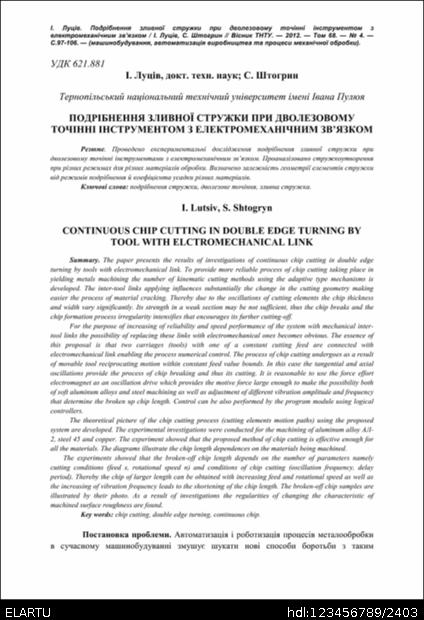Моля, използвайте този идентификатор за цитиране или линк към този публикация:
http://elartu.tntu.edu.ua/handle/123456789/2403

| Заглавие: | Подрібнення зливної стружки при дволезовому точінні інструментом з електромеханічним зв’язком |
| Други Заглавия: | Continuous chip cutting in double edge turning by tool with elctromechanical link |
| Автори: | Луців, Ігор Володимирович Штогрин, Степан Lutsiv, I. Shtogryn, S. |
| Bibliographic description (Ukraine): | І. Луців. Подрібнення зливної стружки при дволезовому точінні інструментом з електромеханічним зв’язком / І. Луців, С. Штогрин // Вісник ТНТУ. — 2012. — Том 68. — № 4. — С.97-106. — (машинобудування, автоматизація виробництва та процеси механічної обробки). |
| Дата на Публикуване: | 6-Ное-2012 |
| Date of entry: | 24-Сеп-2013 |
| Издател: | Тернопільський національний технічний університет ім. Івана Пулюя |
| Place of the edition/event: | Тернопіль, Україна |
| UDC: | 621.881 |
| Ключови Думи: | подрібнення стружки дволезове точіння зливна стружка chip cutting double edge turning continuous chip |
| Резюме: | Проведено експериментальні дослідження подрібнення зливної стружки при дволезовому точінні інструментами з електромеханічним зв’язком. Проаналізовано стружкоутворення при різних режимах для різних матеріалів обробки. Визначено залежність геометрії елементів стружки від режимів подрібнення й коефіцієнта усадки різних матеріалів. The paper presents the results of investigations of continuous chip cutting in double edge turning by tools with electromechanical link. To provide more reliable process of chip cutting taking place in yielding metals machining the number of kinematic cutting methods using the adaptive type mechanisms is developed. The inter-tool links applying influences substantially the change in the cutting geometry making easier the process of material cracking. Thereby due to the oscillations of cutting elements the chip thickness and width vary significantly. Its strength in a weak section may be not sufficient, thus the chip breaks and the chip formation process irregularity intensifies that encourages its further cutting-off. For the purpose of increasing of reliability and speed performance of the system with mechanical inter-tool links the possibility of replacing these links with electromechanical ones becomes obvious. The essence of this proposal is that two carriages (tools) with one of a constant cutting feed are connected with electromechanical link enabling the process numerical control. The process of chip cutting undergoes as a result of movable tool reciprocating motion within constant feed value bounds. In this case the tangential and axial oscillations provide the process of chip breaking and thus its cutting. It is reasonable to use the force effort electromagnet as an oscillation drive which provides the motive force large enough to make the possibility both of soft aluminum alloys and steel machining as well as adjustment of different vibration amplitude and frequency that determine the broken up chip length. Control can be also performed by the program module using logical controllers. The theoretical picture of the chip cutting process (cutting elements motion paths) using the proposed system are developed. The experimental investigations were conducted for the machining of aluminum alloy АЛ-2, steel 45 and copper. The experiment showed that the proposed method of chip cutting is effective enough for all the materials. The diagrams illustrate the chip length dependences on the materials being machined. The experiments showed that the broken-off chip length depends on the number of parameters namely cutting conditions (feed s, rotational speed n) and conditions of chip cutting (oscillation frequency, delay period). Thereby the chip of larger length can be obtained with increasing feed and rotational speed as well as the increasing of vibration frequency leads to the shortening of the chip length. The broken-off chip samples are illustrated by their photo. As a result of investigations the regularities of changing the characteristic of machined surface roughness are found. |
| URI: | http://elartu.tntu.edu.ua/handle/123456789/2403 |
| ISSN: | 1727-7108 |
| Copyright owner: | © „Вісник Тернопільського національного технічного університету“ |
| Publications status : | Опубліковано раніше |
| Content type: | Article |
| Показва се в Колекции: | Вісник ТНТУ, 2012, № 4 (68) |
Файлове в Този Публикация:
Публикацияте в DSpace са защитени с авторско право, с всички права запазени, освен ако не е указно друго.